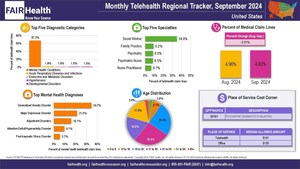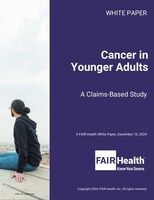Laboratory Services Associated with Diagnoses of Anaphylactic Food Reaction Increased 871 Percent from 2007 to 2016
FAIR Health Reports Billed Charges for Those Services Increased 5,390 Percent
NEW YORK, Nov. 22, 2017 /PRNewswire-USNewswire/ -- The number of laboratory services associated with diagnoses of anaphylactic food reaction increased 871 percent from 2007 to 2016, and the amount of billed charges for those services increased even more—5,390 percent—in the same period, according to research from FAIR Health, a national, independent, nonprofit organization dedicated to bringing transparency to healthcare costs and health insurance information. In a new white paper, Food Allergy in the United States: Recent Trends and Costs—An Analysis of Private Claims Data, FAIR Health analyzed data from its database of more than 24 billion privately billed healthcare claims to study many aspects of food allergy, including geography; anaphylactic food reactions (severe, life-threatening reactions to certain foods); age; gender; places of service; most common treatments and services; and costs and number of services per patient. This white paper has been made possible in part with the generous funding of Food Allergy Research & Education (FARE).
Other findings reported in the white paper include:
Geographic Patterns
In many states, claim lines with food allergy diagnoses represented an increasing share of all medical claim lines from 2009 to 2016. The association between states and food allergy fluctuated over time. In 2009, the five states with the highest percentage of claim lines with food allergy diagnoses compared to all medical claim lines were (in order from highest) New York, Georgia, Colorado, North Dakota and Ohio. The top five states in 2016 were (in order from highest) North Carolina, North Dakota, New Jersey, Washington, DC, and Connecticut. Only North Dakota remained in the top five in both years.
Anaphylactic Food Reactions
From 2007 to 2016, claim lines with diagnoses of anaphylactic food reactions rose 377 percent.
Age
Different allergies were associated with different age groups. In the period 2007-2016, the age group 6-10 years accounted for 28 percent of all claim lines with peanut allergy diagnoses—but only 9 percent of all claim lines with food additive allergy diagnoses. Conversely, the age group 51-60 years accounted for 1 percent of claim lines with peanut allergy diagnoses, but 17 percent of claim lines with food additive allergy diagnoses.
Gender
In the period 2007-2016, claim lines with food allergy diagnoses were associated with boys more than girls from birth through age 18. However, for individuals older than 18 years the reverse was true: Food allergy claim lines were associated with women more than men.
Treatments and Services: Procedure Code Categories
Office or outpatient services to an established patient, immunology services and allergy testing were, respectively, the first, second and third most common procedure code categories of treatments and services associated with food allergy diagnoses in the period 2007-2016.
Costs and Number of Services per Patient
Milk product allergy was the food allergy with the highest average costs and services per patient in 2016. Among patients diagnosed with anaphylactic food reactions in 2016, the highest average costs (both charges and allowed amounts) per patient were for anaphylactic reaction to fish.
"Food allergy is an issue of growing national health concern," stated FAIR Health President Robin Gelburd. "It is our hope that FAIR Health data can help inform public policy and spur further research into this issue."
"This white paper uncovers critical facts about food allergy in a manner that we haven't previously seen," commented James R. Baker, Jr., MD, CEO and chief medical officer of FARE. "The FAIR Health data collection presents an unparalleled window into the costs, demographic factors and geographic patterns of this public health issue. In our role representing millions of Americans affected by food allergy, these findings are critically important as we continue our efforts to improve the quality of life of all those living with food allergies. We at FARE remain concerned that this issue is underappreciated by the public and policy makers."
For the full white paper, click here. See also the infographic.
Follow us on Twitter @FAIRHealth
About FAIR Health
FAIR Health is a national, independent, nonprofit organization dedicated to bringing transparency to healthcare costs and health insurance information through data products, consumer resources and health systems research support. FAIR Health possesses the nation's largest collection of private healthcare claims data, which includes over 24 billion claim records contributed by payors and administrators who insure or process claims for private insurance plans covering more than 150 million individuals. FAIR Health also oversees separate data representing the experience of more than 55 million individuals enrolled in Medicare. Certified by the Centers for Medicare & Medicaid Services (CMS) as a Qualified Entity, FAIR Health receives all of Medicare Parts A, B and D claims data for use in nationwide transparency efforts. FAIR Health licenses its privately billed data and data products—including benchmark modules, data visualizations, custom analytics, episodes of care analytics and market indices—to commercial insurers and self-insurers, employers, hospitals and healthcare systems, government agencies, researchers and others. FAIR Health has earned HITRUST CSF and Service Organization Controls (SOC 2) certifications by meeting the rigorous data security standards of those organizations. As a testament to the reliability and objectivity of FAIR Health data, the data have been incorporated in statutes and regulations around the country and designated as the official, neutral data source for a variety of state health programs, including workers' compensation and personal injury protection (PIP) programs. FAIR Health data serve as an official reference point in support of certain state balance billing laws that protect consumers against bills for surprise out-of-network and emergency services. FAIR Health also uses its database to power a free consumer website available in English and Spanish and an English/Spanish mobile app, which enable consumers to estimate and plan their healthcare expenditures and offer a rich educational platform on health insurance. The website has been honored by the White House Summit on Smart Disclosure, the Agency for Healthcare Research and Quality (AHRQ), URAC, the eHealthcare Leadership Awards, appPicker, Employee Benefit News and Kiplinger's Personal Finance. FAIR Health also is named a top resource for patients in Elisabeth Rosenthal's book, An American Sickness: How Healthcare Became Big Business and How You Can Take It Back. For more information on FAIR Health, visit fairhealth.org.
About FARE
Food Allergy Research & Education (FARE) works on behalf of the 15 million Americans with food allergies, including all those at risk for life-threatening anaphylaxis. This potentially deadly disease affects 1 in every 13 children in the United States—or roughly two in every classroom. FARE's mission is to improve the quality of life and the health of individuals with food allergies, and to provide them hope through the promise of new treatments. Our work is organized around three core tenets: LIFE—support the ability of individuals with food allergies to live safe, productive lives with the respect of others through our education and advocacy initiatives; HEALTH—enhance the healthcare access of individuals with food allergies to state-of-the-art diagnosis and treatment; and HOPE—encourage and fund research in both industry and academia that promises new therapies to improve the allergic condition. For more information, please visit www.foodallergy.org and find us on Twitter@FoodAllergy, Facebook, YouTube and Pinterest.
Contact:
Dean Sicoli
Executive Director of Communications and Public Relations
FAIR Health
646-664-1645
[email protected]
SOURCE FAIR Health
Related Links
WANT YOUR COMPANY'S NEWS FEATURED ON PRNEWSWIRE.COM?
Newsrooms &
Influencers
Digital Media
Outlets
Journalists
Opted In






Share this article